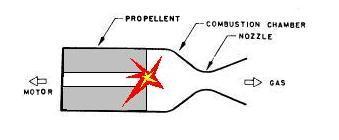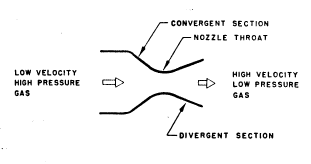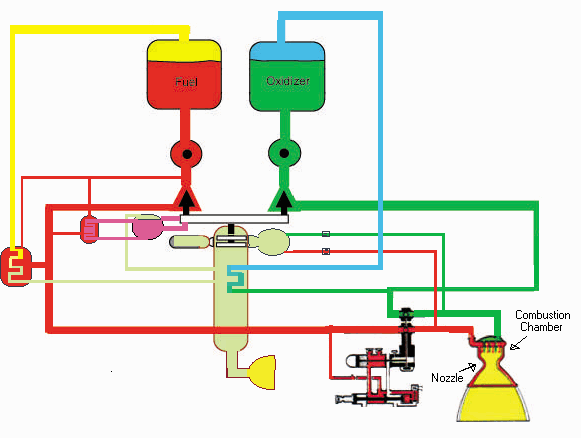 Rocketry
Rocketry Rocketry
RocketryAn Introduction to Rocketry
The first solid-fueled rockets were invented by the Chinese around the year 100. These early rockets worked by burning gunpower in a combustion chamber, and then directing the hot gas released out of a nozzle. In this way, the gas pushed the rocket through the air, like what happens when you blow-up a ballon and let it go. Fifteen-hundred years later, Isaac Newton would explain this with his Third Law of Motion: "For every action there is an equal and opposite reaction."

When the Europeans learned about rockets in the 19th century, they were quick to apply ther knowledge of chemistry to rocket design. The Europeans devised fuels more effective than gunpowder. Also, Europeans developed more efficent nozzles to channel the gases of the rocket. The most notable of these is the DeLaval nozzle, which is used in every rocket engine in use today. Gustav DeLaval was a Swedish engineer of French descent. He invented his nozzle design while he was working on steam engines. One of his designs for a steam turbine used jets of hot steam to turn itself. The faster the jets, the faster the turbine would spin, and the more power it would produce. Delaval found that the most effective way to get a high speed jet was with a nozzle that alternately converged and diverged:

The key to the DeLaval nozzle was this: as the nozzle narrowed, the jet's speed would increase. By carefully constructing the nozzle, the jet could be made to go supersonic just as it reached the nozzle throat. Now traveling faster than sound, the jet would move into the divergent section of the nozzle. Because the jet was supersonic, its speed would increase again as the nozzle diverged. However, if the jet was not supersonic by the time the nozzle began to diverge, its speed would decrease and the rocket would lose its thrust. Additionally, if the jet passed the sound barrier before reaching the throat, the narrowing walls would force it to slow down. Obviously DeLaval nozzles needed to be constructed exactly for their best performance.
In 1915, a yound man named Robert Goddard from Worcester MA, began experimenting with rockets. One of the problem that he found with the rockets of the time was that they were not very efficent. Only 2% of the energy released was used to accelerate the exhaust. Since a faster exhaust means more power, Goddard looked for effective ways to channel the exhaust. After reading about DeLaval's work, Goddard made one of the nozzles for a rocket he was building. When he tested it, the rocket had an efficency of 63%. This is far more efficent than any other engine. Steam engines can get up to 21%, and Diesels can reach 40%. Goddard realized that with such high efficentcies, rockets would be instrumental in probing the high atmostshpere and beyond. Goddard was able to get a grant from the Smithsonain to pursue this line of research. Unfortunately, America's entry into the First World War meant that Goddard would have to put his work on hold for awhile in the face of more pressing war problems.
After the war, Goddard returned to his rockets. He continued to experiment with various solid fuels for his rockets, but in 1922 he started designing a liquid-fueled rocket. Liquid-fueled rockets differed from solids in many ways, and posed serious technical challenges. Just by looking at a diagram of a liquid-fueled engine you can see how complex it is:

Looking more closely, you can see the parts of a rocket that we are familiar with: the combustion chamber and the nozzle. Up at the top of the diagram are the tanks which hold the fuel and the oxidizer. Everything else on the diagram is simply there to move the fuel and the oxidizer from their tanks to the combustion chamber. The oxidizer provides the oxygen for burning the fuel. In solid-fueled rockets the oxidizer is mixed in with the fuel. Liquid-fueled rockets, however, have to keep the fuel and oxidizer seperate. Some different types of oxidizers are liquid oxygen and hydrogen peroxide. Liquid-fueled rockets have several advantages over solids. They can vary the amount of thrust, they are reusable, and they can be restarted once they are shut off. Solids, on the other hand, burn completely and at a constant rate once they are lit.
Constructing liquid-fueled rockets is not an easy task. They burn at much higher temperatures than solids, and they require precision machines to keep them operating. It took Goddard four years to build his first flyable rocket. He tested it in March of 1926. For the first twenty-seconds of the test, the rocket sat on the ground, burning off fuel, until it became light enough and took-off to an altitude of 41 feet. It then promptly leveled off and flew into a neighbor's cabbage patch. In total, the rocket had been in the air for only 2.5 seconds. While unimpressive by today's standards, Goddard's test is considered the "Kitty Hawk" of rocketry.
In the years following Goddard's flight, rocketry evolved
rapidly. Several designs were studied that moved away from chemical
fuel entirely. Engineers looked at everything from ion engines to
pulsed-nuclear propulsion. Throughout all of this, chemical rockets
continued to get bigger and more powerful. Their development
culminated in the first flight of the Saturn V in 1967. The
Saturn V generated a million and a half times more thrust than
Goddard's first rocket. It could send two Space Shuttle
flights worth of payload to the Moon. Unfortunately, when the
Apollo Program was canceled in 1972, the Saturn V was
retired. No other rocket in operation today can match the
performance of the Saturn V.
Safety Note: In both of these activities, especially the second, proper safety precautions should be taken. Students should wear eye-protection and stand well clear of the launching and recovery area. Futhermore, the rockets described above explode very easily and should only be built by someone who thoroughly understands the technique and theory of rocketry.
Group size
1 person
Time required
Two 50 Minute Periods
Materials
Student Objectives
Student will:
Newton's Third Law (action and reaction), and a basic understanding of pressure.
Advance Preparation Time
Make sure that there are enough materials for all of the
students.
Lesson Activity:
Step 1
Each student should read An Introduction to
Rocketry at the beginning of this page. Answer any questions
they might have.
Step 2
Show the students a completed paper rocket. Launch it across the
room to give the students an idea of what they're going to do.
Print out the construction guide, and give
one to each student. Have them follow the directions and build
their own rocket. Set up a launching area with distance markers and
have each student see how far they can fly their rocket. Let them
try a few times, and have them record their results. Ask them to
think about how to build a better rocket.
Step 3
The next day, have the students build rockets of their own design.
Again, laucnh them a few times and record the results. To speed
things up, let each student launch as soon as they're done building
their rocket. Keep building and launching the rockets until time
runs out.
Step 4
Have each student write a paragraph about their best rocket. They
should say how far it went and why they think it was successful.
Have them compare it to another rocket; either one of their own or
to a classmate's.
Group size
2 people
Time required
Three 50 Minute Periods
Materials
Student Objectives
Student will:
Newton's Third Law (action and reaction), and a knowledge of pressure.
Advance Preparation Time
Make sure that there are enough materials for all of the students,
construct the air-compressor rig, and read the safety note at the
beginning of the Activities section.
Lesson Activity:
Step 1
Each student should read An Introduction to
Rocketry at the beginning of this page. Answer any questions
they might have.
Step 2
Have the students split into groups of two. ROCKET INSTRUCTIONS
HERE
Step 3
Find a nice clear area to launch from; sports fields are ideal.
Appoint one student to the position of "Range Safety Officer." He
or she should make sure that the rocket recovery area is clear of
people before any launching occurs. At this point, the students
have a choice. They can either try to go for distance or for height
with their rocket. Once they have decided, have them launch the
rocket however they want to. If they are going for distance, use
the tape measure to measure how far they flew from the launch pad.
Alternatively, you can place markers at 10 foot intervals down the
field for the students to measure how far the rocket flew. If the
students decide to try for height, once again let them launch
however they want. To measure how high they go, use an Altitude
Tracker (from the STO site). Have the students launch as many
times as they can in one period, and record all of their results,
such as the launch angle, and the distance or height.
Step 4
Have your students design their own rocket. Things to change would
be the placement and number of fins, the weight in the nose cone,
and the amount of tape they use on their rocket. Have the students
launch their rockets again, going for distance or height, and have
them record the results along with a drawing of their new
rocket.
Step 5
Each of your students should write up a paragraph describing how
well their rocket flew. Have them compare it to their first rocket,
or a peer's, and explain why their's performed better or worse. If
you want, you can give out prizes to the groups that went the
farthest and highest.
Author: Thomas Beatty
|
Curator: Al Globus If you find any errors on this page contact Al Globus. |
 |
This site was hosted by the NASA Ames Research Center from 1994-2018 and is now hosted by:
